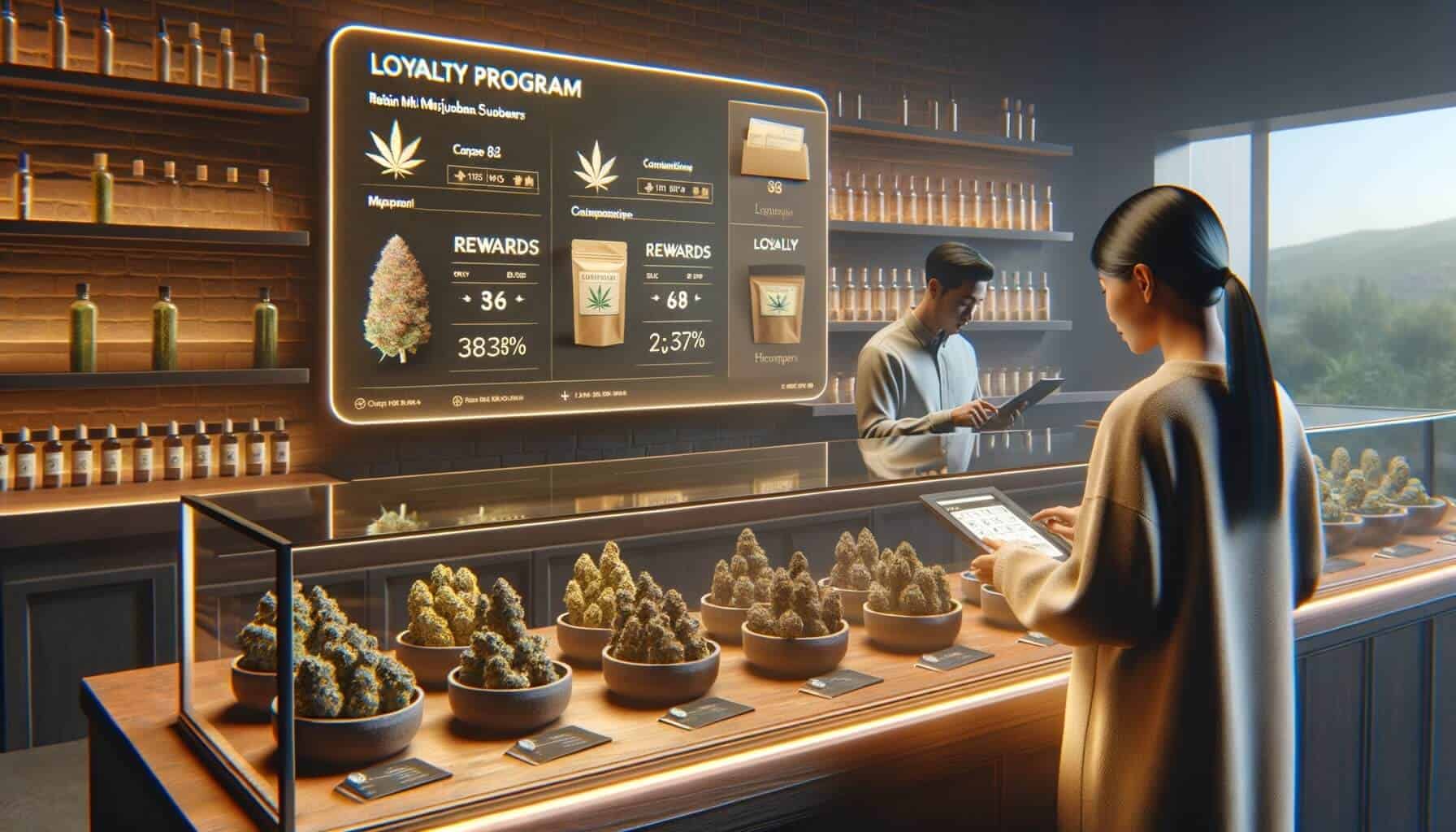
By Karen Henriques March 5, 2025
In recent years, the marijuana industry has experienced significant growth and expansion, with more states legalizing both medical and recreational use. As the market becomes increasingly competitive, marijuana businesses are faced with the challenge of attracting and retaining customers. One effective strategy to achieve customer retention is by establishing a loyalty program.
In this article, we will explore the benefits of implementing a loyalty program for marijuana businesses, how to identify and analyze your target audience, key elements and strategies for designing an effective loyalty program, choosing the right rewards and incentives, implementing seamless technology solutions, tracking and analyzing customer data, promoting and marketing, and common challenges and solutions in establishing a loyalty program for marijuana businesses.
The Benefits of Implementing a Loyalty Program for Marijuana Businesses

1. Increased Customer Retention: One of the primary benefits of implementing a loyalty program is increased customer retention. By offering rewards and incentives to loyal customers, you create a sense of value and appreciation, which encourages them to continue purchasing from your business. According to a study by Bain & Company, increasing customer retention rates by just 5% can lead to a 25% to 95% increase in profits.
2. Enhanced Customer Engagement: A loyalty program provides an opportunity to engage with your customers on a deeper level. By collecting customer data and analyzing their preferences and behaviors, you can tailor your offerings and communication to meet their specific needs. This personalized approach fosters a stronger connection between your business and your customers, leading to increased loyalty and advocacy.
3. Competitive Advantage: In a crowded marketplace, a well-designed loyalty program can give your business a competitive edge. By offering unique rewards and incentives, you differentiate yourself from your competitors and attract new customers.
4. Increased Sales and Revenue: A loyalty program can drive repeat purchases and increase customer spending. When customers know they are working towards earning rewards or discounts, they are more likely to make additional purchases to reach those goals.
5. Data Collection and Analysis: Implementing a loyalty program allows you to collect valuable customer data, such as purchase history, preferences, and demographics. This data can be used to gain insights into your target audience, identify trends, and make data-driven business decisions. By understanding your customers better, you can tailor your offerings and marketing strategies to maximize their satisfaction and loyalty.
Identifying and Analyzing Your Target Audience for a Successful Loyalty Program

Before designing a loyalty program, it is crucial to identify and analyze your target audience. Understanding your customers’ demographics, preferences, and behaviors will help you create a program that resonates with them and drives engagement. Here are some steps to follow:
1. Conduct Market Research: Start by conducting market research to gain insights into the demographics and psychographics of your target audience. This can be done through surveys, focus groups, or analyzing existing customer data. Identify key characteristics such as age, gender, location, income level, and lifestyle preferences.
2. Analyze Customer Data: If you already have an existing customer base, analyze their purchase history, preferences, and behaviors. Look for patterns and trends that can help you understand what motivates them to make purchases and what types of rewards or incentives would be most appealing to them.
3. Segment Your Audience: Once you have gathered the necessary data, segment your audience into different groups based on their characteristics and preferences. This will allow you to create targeted loyalty programs that cater to the specific needs and interests of each segment.
4. Create Customer Personas: Develop customer personas based on your audience segments. Customer personas are fictional representations of your ideal customers and help you understand their motivations, goals, and pain points. Use these personas as a reference when designing your loyalty program to ensure it aligns with their needs and desires.
5. Test and Refine: After implementing your loyalty program, continuously monitor and analyze customer data to assess its effectiveness. Collect feedback from your customers through surveys or focus groups to understand their satisfaction levels and identify areas for improvement.
Designing an Effective Loyalty Program: Key Elements and Strategies

Designing an effective loyalty program requires careful consideration of key elements and strategies. Here are some essential components to include:
1. Clear and Attainable Rewards Structure: Define a clear and attainable rewards structure that outlines how customers can earn and redeem rewards. Make sure the rewards are valuable and relevant to your target audience. Consider offering tiered rewards based on customer loyalty levels to incentivize repeat purchases and increase engagement.
2. Multiple Engagement Channels: Provide multiple engagement channels for customers to interact with your loyalty program. This can include a mobile app, website, or in-store kiosks. Ensure that these channels are user-friendly and accessible to all customers, regardless of their technological proficiency.
3. Gamification Elements: Incorporate gamification elements into your loyalty program to make it more engaging and enjoyable for customers. This can include challenges, badges, or leaderboards that encourage friendly competition and reward customers for their loyalty.
4. Personalized Communication: Use customer data to personalize your communication with loyalty program members. Send targeted offers, recommendations, and exclusive content based on their preferences and purchase history. Personalization creates a sense of exclusivity and makes customers feel valued.
5. Social Sharing and Referral Programs: Encourage customers to share their loyalty program experiences on social media and refer their friends and family. Offer incentives for referrals, such as bonus points or discounts, to incentivize word-of-mouth marketing and expand your customer base.
6. Limited-Time Offers and Special Events: Create a sense of urgency and excitement by offering limited-time promotions and hosting special events exclusively for loyalty program members. This creates a sense of exclusivity and encourages customers to take advantage of the offers.
7. Seamless Integration with Point-of-Sale Systems: Ensure that your loyalty program seamlessly integrates with your point-of-sale systems to track customer purchases and reward them accordingly. This integration allows for a seamless customer experience and eliminates the need for manual tracking and redemption processes.
Choosing the Right Rewards and Incentives to Drive Customer Loyalty

Choosing the right rewards and incentives is crucial to driving customer loyalty and engagement. Here are some factors to consider when selecting rewards:
1. Value and Relevance: The rewards you offer should provide value to your customers and be relevant to their interests and preferences. Consider conducting surveys or focus groups to understand what types of rewards would be most appealing to your target audience.
2. Tiered Rewards: Consider implementing a tiered rewards system where customers can unlock higher-value rewards as they progress through different loyalty levels. This encourages repeat purchases and incentivizes customers to reach higher tiers.
3. Exclusive Access and Experiences: Offer exclusive access to new products, events, or experiences as rewards for loyalty program members. This creates a sense of exclusivity and makes customers feel special and valued.
4. Discounts and Freebies: Discounts and freebies are popular incentives that can drive customer loyalty. Consider offering percentage discounts, buy-one-get-one-free offers, or free samples as rewards for loyalty program members.
5. Points-Based System: Implement a points-based system where customers earn points for every purchase they make. These points can then be redeemed for rewards or discounts. This system provides a clear and tangible way for customers to track their progress and encourages repeat purchases.
6. Personalized Offers: Use customer data to personalize offers and rewards based on individual preferences and purchase history. This makes customers feel understood and appreciated, increasing their loyalty to your business.
7. Charitable Donations: Consider allowing customers to donate their rewards or a portion of their purchases to a charitable cause. This not only creates a positive brand image but also appeals to customers who value social responsibility.
Implementing a Seamless Loyalty Program: Technology and Software Solutions
Implementing a seamless loyalty program requires the use of technology and software solutions. Here are some key considerations when choosing technology solutions for your loyalty program:
1. Mobile Applications: Develop a mobile application that allows customers to easily access and manage their loyalty program accounts. The app should provide a user-friendly interface, allow customers to track their rewards and progress, and receive personalized offers and notifications.
2. Customer Relationship Management (CRM) Software: Invest in a CRM software that integrates with your loyalty program and allows you to collect and analyze customer data. This software should provide insights into customer behavior, preferences, and purchase history, enabling you to personalize your offerings and communication.
3. Point-of-Sale Integration: Ensure that your loyalty program seamlessly integrates with your point-of-sale systems. This integration allows for real-time tracking of customer purchases and automatic reward redemption, eliminating the need for manual processes.
4. Data Security: Implement robust data security measures to protect customer information and ensure compliance with privacy regulations. This includes encryption, secure servers, and regular security audits.
5. Customer Support: Provide customer support channels, such as live chat or a dedicated helpline, to assist customers with any issues or inquiries related to the loyalty program. Prompt and efficient customer support enhances the overall customer experience and increases satisfaction.
6. Analytics and Reporting: Choose a technology solution that provides robust analytics and reporting capabilities. This allows you to track the performance of your loyalty program, measure customer engagement, and make data-driven decisions to optimize your program.
Tracking and Analyzing Customer Data to Optimize Your Loyalty Program
Tracking and analyzing customer data is essential to optimize your loyalty program and ensure its effectiveness. Here are some key steps to follow:
1. Define Key Performance Indicators (KPIs): Identify the key metrics that will help you measure the success of your loyalty program. This can include customer retention rate, average purchase frequency, customer lifetime value, and redemption rate. Set specific targets for each KPI to track your progress.
2. Collect and Centralize Data: Implement a system to collect and centralize customer data from various sources, such as point-of-sale systems, CRM software, and loyalty program interactions. This allows for a comprehensive view of customer behavior and preferences.
3. Analyze Customer Segments: Analyze customer data to identify patterns and trends within different customer segments. Look for insights into their purchasing behavior, preferences, and engagement levels. This analysis will help you tailor your loyalty program to meet the specific needs of each segment.
4. Conduct A/B Testing: Test different elements of your loyalty program, such as rewards, communication strategies, or engagement channels, through A/B testing. This allows you to compare the performance of different variations and make data-driven decisions to optimize your program.
5. Monitor Customer Feedback: Collect feedback from your customers through surveys, focus groups, or social media listening. This feedback provides valuable insights into customer satisfaction, pain points, and suggestions for improvement. Use this feedback to make necessary adjustments to your loyalty program.
6. Use Predictive Analytics: Utilize predictive analytics to forecast customer behavior and identify potential churn risks. By analyzing historical data and customer patterns, you can proactively target at-risk customers with personalized offers or interventions to prevent churn.
7. Continuously Iterate and Improve: Use the insights gained from data analysis to continuously iterate and improve your loyalty program. Regularly review your KPIs, make necessary adjustments, and test new strategies to optimize customer engagement and loyalty.
Promoting and Marketing Your Loyalty Program to Maximize Customer Engagement
Promoting and marketing your loyalty program is crucial to maximize customer engagement and drive participation. Here are some effective strategies to consider:
1. Multi-Channel Promotion: Promote your loyalty program through multiple channels to reach a wider audience. This can include your website, social media platforms, email marketing, in-store signage, and mobile app notifications. Ensure that your messaging is consistent across all channels and clearly communicates the benefits of joining the program.
2. Incentivize Sign-Ups: Offer an incentive for customers to sign up for your loyalty program, such as bonus points or a welcome discount. This encourages customers to join and experience the immediate benefits of being a loyalty program member.
3. Referral Program: Implement a referral program where existing loyalty program members can earn additional rewards for referring their friends and family. This incentivizes word-of-mouth marketing and expands your customer base.
4. Social Media Campaigns: Leverage social media platforms to create awareness and generate excitement around your loyalty program. Run contests, share success stories, and highlight exclusive offers to encourage customer engagement and participation.
5. Email Marketing: Utilize email marketing to communicate with your loyalty program members and keep them informed about new rewards, promotions, and exclusive events. Personalize your emails based on customer preferences and purchase history to increase open rates and engagement.
6. In-Store Signage and Point-of-Sale Promotion: Display signage in your physical store locations to promote your loyalty program and encourage sign-ups. Train your staff to inform customers about the program and its benefits during the checkout process.
7. Partnerships and Cross-Promotion: Collaborate with other businesses or brands to cross-promote your loyalty program. This can include joint marketing campaigns, co-branded rewards, or exclusive offers for customers of both businesses. This strategy expands your reach and attracts new customers who may be interested in your products or services.
Common Challenges and Solutions in Establishing a Loyalty Program for Marijuana Businesses
1. Legal and Regulatory Considerations: The marijuana industry is heavily regulated, and loyalty programs must comply with all applicable laws and regulations. Ensure that your loyalty program does not violate any state or local laws regarding the sale and promotion of marijuana products. Consult with legal experts to ensure compliance and avoid any potential legal issues.
2. Data Privacy and Security: Collecting and storing customer data comes with the responsibility of protecting their privacy and ensuring data security. Implement robust data protection measures, such as encryption and secure servers, to safeguard customer information. Clearly communicate your data privacy policy to customers and obtain their consent for data collection and usage.
3. Program Adoption and Engagement: One common challenge in establishing a loyalty program is getting customers to sign up and actively participate. To overcome this challenge, clearly communicate the benefits of the program to customers and make the sign-up process simple and straightforward. Consider offering an initial sign-up bonus or exclusive rewards for new members to incentivize participation.
4. Program Differentiation: With the increasing number of marijuana businesses implementing loyalty programs, it is essential to differentiate your program from competitors. Conduct market research to understand what other businesses are offering and identify gaps or opportunities for differentiation. Consider unique rewards or incentives that align with your brand and resonate with your target audience.
FAQs
Q1. How can I measure the success of my loyalty program?
Answer: A loyalty program’s success can be measured through various metrics, including customer retention rates, average order value, customer lifetime value, and program engagement. Analyze these metrics regularly to assess the effectiveness of your program and make necessary adjustments.
Q2. Can I offer rewards that include marijuana products?
Answer: The legality of offering marijuana products as rewards may vary depending on the state and local regulations. Consult with legal experts to ensure compliance with all applicable laws and regulations.
Q3. How can I promote my loyalty program?
Answer: Promote your loyalty program through various channels, including your website, social media platforms, email marketing, and in-store signage. Clearly communicate the benefits of the program and encourage customers to sign up and participate.
Q4. How often should I update my loyalty program?
Answer: Regularly evaluate and update your loyalty program to keep it fresh and engaging. Consider gathering feedback from customers to identify areas for improvement and make adjustments accordingly.
Conclusion
Establishing a loyalty program is a valuable strategy for marijuana businesses looking to attract and retain customers in an increasingly competitive market. By understanding the importance of loyalty programs, identifying and analyzing your target audience, designing an effective program, and choosing the right rewards and incentives, you can create a program that drives customer loyalty and enhances the overall customer experience.
While there may be challenges in establishing a loyalty program for marijuana businesses, with careful planning and consideration, these challenges can be overcome. By implementing a well-designed loyalty program, marijuana businesses can differentiate themselves from competitors, increase customer retention, and ultimately drive business growth.